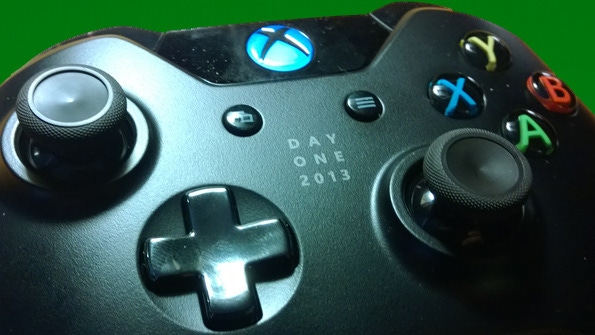Xbox One: Controller Matters
A great new controller, but some changes you should know about
November 23, 2013

With the euphoria of Xbox One's first day behind us—over one million consoles sold to consumers, biggest launch in Xbox history, and so on—it's time to turn our attention to more pragmatic matters. For me, that means learning how this darn thing works. First up, the new Xbox One wireless controller.
Honestly, it's been a bit of a rough start. While the Xbox One Dashboard looks and works much like Windows 8.1, it's different in key ways, and of course interacting with it via a controller—or, in some cases via voice—raises its own challenges.
Not helping matters, key buttons on the Xbox One controller no longer work as they did before. So let's start there.
As I mentioned last night in Xbox One First Impressions and Photos, the new Xbox One controller is excellent, but it will take a bit of getting used to, and in that way is (so far) little different from the PS4 controller. In games, which will be the primary way I interact with this thing over time, the transition is going pretty smoothly, two changes are a bit off-putting: The triggers kind of grip your pointer fingers in a strange way. And because the d-pad is no longer raised off the surface of the controller, it's harder to reach. Still, my very first "Ghosts" team deathmatch experience went well enough, as evidenced this shot.
Adapting to a controller for gameplay is of course simple enough: It just requires a bit of time, and even if this controller were sub-par, which it's not, you'd get there eventually. But I'm not so concerned with how these buttons work for gaming purposes. That's pretty straightforward and has been explained to death elsewhere. Here, I'd like to discuss some aspects of this controller that have not been properly explained.
For example. The Xbox Guide, Back and Start buttons from the Xbox 360 controller? They're all different now.
Xbox One controller (left), Xbox 360 wireless controller (right)
Xbox button
First, the Xbox Guide button has been replaced by the Xbox button. It glows white when the controller is on and connected to the console, which is interesting because I thought the green parts of the original Xbox controller's Xbox Guide were going to light up and was disappointed when I discovered they did not.
Xbox button
But it's not just about looks: The Xbox button works differently too. Instead of popping up the old Xbox Guide interface, which is gone, it now navigates directly to the Dashboard when pressed. So it works sort of like the Windows key on a Windows PC. (Sort of. It's not really a toggle, as the Windows key is in Windows.) And you can long press the button to display a power menu that lets you turn off the console or the controller.
View button
The small button below and to the left of the Xbox button is called the View button. It replaces the Back button, positionally, from the Xbox 360 controller. But it doesn't do the same thing. In fact, it pretty much doesn't do anything in the Dashboard. Instead, it's designed to be customized by developers for use inside games and apps.
View button
In Call of Duty: Ghosts, for example, the View button is used to toggle the list of players in the game. Oddly, this is different from how this works in the PS4 and Xbox 360 versions of Ghosts, where the right-most of these two small buttons (Options on PS4, Start on the 360) brings up that list. But whatever.
Menu button
The Menu button sits to the right and below the Xbox button, and it replaces the old Start button from the 360 controller. (Again, positionally.) This button works like a right-click or long-tap on a PC: It brings up a context-sensitive menu. And it works throughout the Dashboard UI.
Menu button
If you select a pinned tile on the Dashboard and press the Menu button, a pop-up menu appears with context-sensitive options for Unpin, Move to front, Launch, and See in Xbox Store, plus a second set of global options for Settings, Help and Switch Profile. If the app or game supports it, you may also see options for Snap, Show all add-ins and Uninstall as well.
When you first start navigating around the Dashboard—which will be the topic of my next Xbox One article—you'll spend a lot of time figuring what the new things are, where the familiar things are now located, and how things work. Understanding how the controller works, however, is job one.
More soon.
About the Author
You May Also Like






.jpg?width=700&auto=webp&quality=80&disable=upscale)
